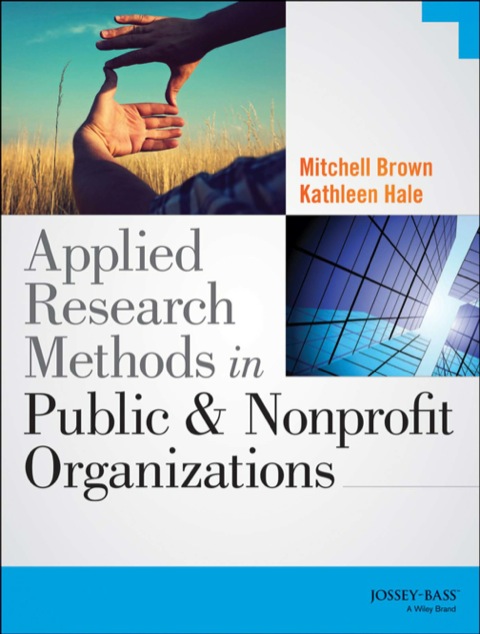Description
Efnisyfirlit
- Applied Research Methods in Public and Nonprofit Organizations
- Copyright
- Contents
- List of Figures and Tables
- Acknowledgments
- The Authors
- Introduction
- Integrating Case Studies into Learning About Applied Research Methods
- The Cases
- Community Garden Initiative: Exploring Community Interest in Local Food Projects
- Statewide Needs Assessment: Understanding the Status of Aging Women
- Election Administration and Technology: Understanding the Implementation and Implications of Electio
- National Program Evaluation: Domestic Violence Prevention and Faith-Based and Community Organization
- Criminal Justice Policy Reform: Exploring Innovation Across Sectors
- Structure of the Book and Message to Instructors
- Part One: Research Basics: What Do We Want to Know and Why?
- Chapter One: Overview and Context of the Research Process
- The Research Process
- The Applied Research Context
- Public Administration, Nonprofit Studies, and Other Subfields
- Information Literacy
- Information Quality and Types of Sources
- Finding High-Quality Information
- Values, Beliefs, and Certainty in Applied Disciplines
- Grand Theory and Theories of the Middle Range
- Case Comparisons
- Ethics and Institutional Review Boards
- Specific Concerns for Public Administration and Nonprofit Studies
- Decision Trees
- Applied Research Project Planning
- Typical IRB Review Considerations
- Conclusion
- Overview of the Book
- Chapter Support Materials
- Chapter One Relevant Articles
- Chapter One Discussion Questions
- Chapter One Practice Assignments
- Chapter One Linked Assignments
- Chapter One Link to Online Assignments
- Chapter Two: Applied Research Questions, Literature, and Theory
- Asking Good Research Questions
- Case Illustrations of Research Questions
- Research Questions and Sponsored Research
- Case Illustrations of Research Questions in Sponsored Research
- Using Literature and Building Theory
- The Literature Review
- Literature Sources
- Literature Searches
- A Note About Citations
- Theory Building
- Developing Research Expectations and Hypotheses
- Theories of Change and Logic Models
- Theories of Change
- Logic Models
- Steps for Development of Theories of Change
- Decision Tree
- Decisions About Applied Research and Using a Theory of Change
- Conclusion
- Chapter Support Materials
- Chapter Two Relevant Articles
- Chapter Two Discussion Questions
- Chapter Two Practice Assignments
- Chapter Two: Linked Assignment
- Chapter Two Link to Online Assignments
- Chapter Three: Applied Research Designs
- General Parameters of Design
- Major Design Types
- Experimental Design
- Quasi-Experimental Design
- Nonexperimental Design
- Case Illustrations of Research Design Approaches
- Sampling
- Random or Probability Sampling
- Nonrandom or Nonprobability Sampling
- Sample Size
- Case Illustrations of Sampling Approaches
- Decision Trees
- Selecting a Research Design Type
- Choosing a Sampling Strategy
- Conclusion
- Chapter Support Materials
- Chapter Three Relevant Articles
- Chapter Three Discussion Questions
- Chapter Three Practice Assignments
- Chapter Three Linked Assignment
- Chapter Three Link to Online Assignments
- Part Two: Data Collection: Where and How Can We Gather Information?
- Chapter Four: Qualitative Data Collection in the Field
- Validity, Reliability, and Error in Qualitative Research
- The Process of Conducting Field Research
- Interviews
- Writing Interview Questions
- Putting Respondents at Ease
- Focus Groups
- Direct Observation
- Content Analysis
- Case Studies
- Case Illustrations of Data Collection
- Statewide Needs Assessment
- Election Administration and Technology
- National Program Evaluation
- Decision Tree
- Data Collection Strategy
- Conclusion
- Chapter Support Materials
- Chapter Four Relevant Articles
- Chapter Four Discussion Questions
- Chapter Four Practice Assignments
- Chapter Four Linked Assignments
- Chapter Four Link to Online Assignments
- Chapter Five: Survey Research
- The Survey Research Process
- Survey Design
- Crafting Quality Questions
- Response Categories
- Demographic Questions
- Problems and Controversies in Survey Research
- Case Illustrations of Survey Use
- Statewide Needs Assessment
- Criminal Justice Policy Reform
- National Program Evaluation
- Decision Tree
- Decisions About Methods of Survey Distribution
- Conclusion
- Chapter Support Materials
- Chapter Five Relevant Articles
- Chapter Five Discussion Questions
- Chapter Five Practice Assignments
- Chapter Five Linked Assignments
- Chapter Five Link to Online Assignments
- Part Three: Analyzing Data and Communicating About Them: What Do They Mean? How Can They Be Used?
- Chapter Six: Data Analysis
- Context and Descriptive Analysis
- Qualitative Analysis
- Quantitative Analysis
- Coding
- Levels of Measurement
- Descriptive Statistics
- Statistical Significance
- Bivariate Statistics
- Multivariate Statistics
- Codebooks
- Case Applications of Qualitative and Quantitative Analysis
- Decision Tree
- Conclusion
- Chapter Support Materials
- Chapter Six Relevant Articles
- Chapter Six Discussion Questions
- Chapter Six Practice Assignments
- Chapter Six Linked Assignments
- Chapter Six Link to Online Assignments
- Chapter Seven: Writing and Presentations
- General Tips for Writing
- A Productive Writing Process
- Feedback and (Constructive) Criticism
- Readability and Appeal
- A Note About Style
- Types of Writing
- Needs Assessments and Asset Mapping
- Grant Applications
- Funder Reports
- Stakeholder Documents
- Journal Articles
- Applied Dissertations
- Presentations
- Presenting Material to Stakeholders
- Academic Presentations
- Case Illustrations of Writing and Presentation
- Decision Tree
- Decisions About Making Presentations
- Conclusion
- Chapter Support Materials
- Chapter Seven Relevant Articles
- Chapter Seven Discussion Questions
- Chapter Seven Practice Assignments
- Chapter Seven Linked Assignments
- Chapter Seven Online Assignments
- Glossary
- Bibliography and Works Cited
- Index
- End User License Agreement







Reviews
There are no reviews yet.